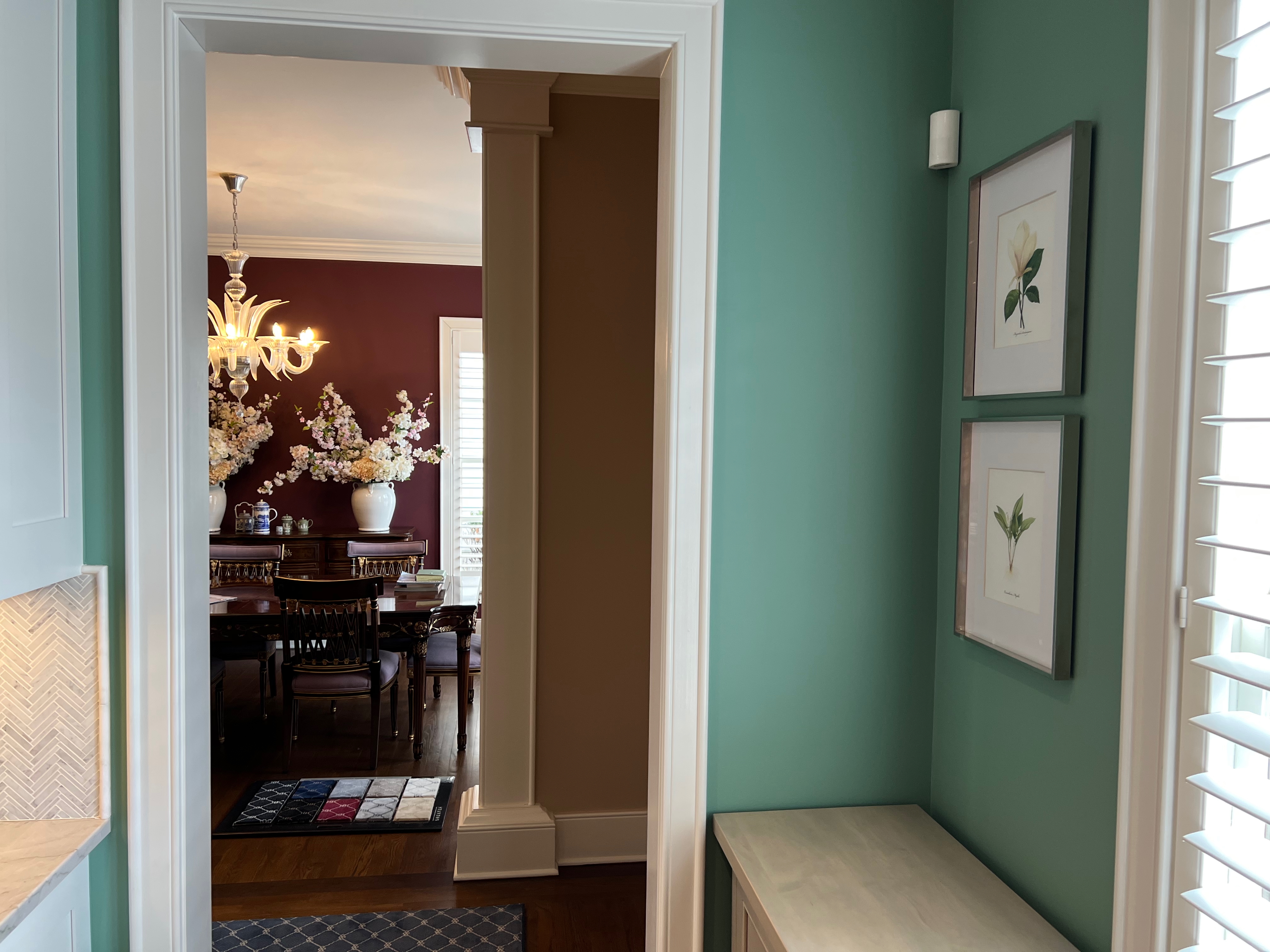One of the questions I get constantly, both in-person and online, is how we went about arranging our household once we became parents. We put so much thought into it, and it’s clearly of interest to folks, that I thought I’d take a moment over my morning coffee and write a brief high-level overview of how we approached this if only for a quick reference guide in the hope it is helpful to someone. It’s also partly my way of paying it forward since both Aaron and I were, and remain, so grateful for the other parents who shared suggestions, ideas, and recommendations about the journey we were about to undertake. It truly is the case that you cannot comprehend the path until you’ve walked it yourself. Kids change everything. Having the boys truly has been both the best, and most difficult, things we’ve ever done because our lives are suddenly not about us anymore. We live for something beyond our own needs and desires, subjugating to a meaningful degree ourselves for the greater good of the family. That change in perspective shifts how one views allocations of time and capital.
To that end: Broadly speaking, Aaron and I have always been big fans of designing systems or frameworks and then setting up our lives and businesses to let those systems or frameworks do the heavy lifting. Those of you who know me realize how true this is. For example, I control my attention span with a certain level of ruthless efficiency because, as an elder millennial, I abhor Silicon Valley’s arrogance thinking it has the right to demand my time. For example:
- I do not allow cell phones or social media or email to have any first, second, or even tertiary, claim on my attention span. They exist for me to utilize, or not utilize, as a tool. I will often have my phone in an adjacent room and only check messages once or twice a day. I have nearly all notifications turned off on all devices.
- I have something like 70 or 80 specialized email addresses and aliases set up to manage personal household functions all going into a centralized system so I can focus on whatever I’m working on all at once, not be distracted. Some email addresses are checked daily, some quarterly, some a few times a year.
- I utilize physical books, print-outs, and/or e-ink readers with no advertisements or other selling features to allow me to focus on whatever text I am studying.
- I do not permit the use of sites like TikTok, partly because as an expert, it is excruciatingly painful to listen to so much misinformation, and partly because I think it is self-defeating to have any sort of short-form content on demand given that it distracts from bigger goals and deeper satisfaction in life. I think the parallels to nicotine are meaningful. Several years ago, when the communication services stocks got cheap and we loaded up on them, I acknowledged this was a battle I was going to lose and the only rational thing was to take advantage of the situation since few people cared to listen to me about it.
Stated another way, I very purposefully built a machine, of sorts, so that I am free to be left alone to think or focus on the people in front of me. I do not believe in centralized devices. Lately, this has me testing running Linux distributions in Docker containers within virtual machines because I want to be able to get around the increasing insistence that everything be interconnected to everything and everyone else. I want to be able to turn on a machine, do specialized work on it, and then turn it off. Nothing may come of this experiment, but it has been a lot of fun to learn the technical side.
Anyway, when we decided to become parents years ago, and went through the time, expense, and emotional process of gestational surrogacy, this was no different. We reflected a lot on how we could give our kids the best possible advantages in life; to help them so that as they grew up, and entered adulthood, they were equipped with the tools to not just enjoy life and succeed, but to thrive. Over the course of a few years, we identified that our goals were to:
- Make them feel emotionally secure;
- Allow them to take risks in a safe environment;
- Help them develop autonomy and a sense of self-direction so they could follow their passions and curiosity;
- Develop emotional regulation;
- Develop strong wills including the ability to delay gratification; and
- Protect their attention span so they did not require constant distraction to be happy or content.
Play Time Is Unrestricted But It Occurs in a Carefully Curated World
We started with the concept of how the kids would play. The general guideline we used was, “If there were no electricity coming into the house, and no internet, this should still provide hours of entertainment by using your imagination playing in a physical real-world space”. We created the space, their playroom, and made sure it was stocked with:
- Books – The library is built out and contains hundreds of books. Storybooks. Comic books. Science encyclopedias on different topics such as the universe or North American birds.
- Boardgames – Physical, old-school boardgames, puzzles, and card games. Chutes & Ladders. Candy Land. Hi-Ho Cherry-O. Slapburger.
- Musical Instruments – Besides the two acoustic pianos, we bought them Yamaha recorders, a Chinese tongue drum, a tambourine, etc.
- Physical Play Sets – Wooden replica kid-sized kitchen with cookware, pretend ice cream shops, sandwich shops, etc.
- Engineering Toys – Wooden train tracks, magnetic engineering tiles, Lincoln Logs, building blocks, Hot Wheels, construction equipment replicas from dump trucks to cranes.
- Figurines and Plush Toys – Play sets from movies such as Encanto or Frozen, a ton of Jellycat plush friends, etc.
- Costumes – This includes not only costumes but the accessories such as wigs and props.
- Art Sets – Play-doh sets, watercolors, coloring books, sticker books, etc.
- Physical Activity – Bicycles, tricycles, sidewalk chalk, and other things that can be used outside.
Play is generally unrestricted so they can entertain themselves by creating new games or stories. (Don’t get me wrong, we do things like enroll them in swimming lessons, but everything I’ve ever seen shows the importance of free, creative time in childhood development so kids learn how to function and self-regulate rather than rely on authority figures to fill their day on a pre-determined path.) It’s been wild to see how they use that freedom. I’m sure I’m misremembering some of the details given how many variations there are but they’ve built jails out of their engineering tiles, and the Teenage Mutant Ninja Turtles have locked away bad guys that were arrested by Elsa from Frozen using her ice powers only to have said bad guys escape and destroy a passing train. There was one period where nearly everything was a magic wand and we kept hearing yells of “Fireball!” throughout the house as they pretended to have battle royales.
While play itself is unstructured, the house is not. This not only helped keep us sane, it also reinforced the magic of the playroom. For example, when we setup the playroom for them, we made them a deal: We would build them a childhood paradise but toys must remain in the playroom. They are never left out around the house or strewn across the stairs. If they are, they lose them. They get their space, but I get mine for things to be clean and organized. The playroom itself, in contrast, has only a couple of rules:
- If the playroom gets too messy to the point it is a tripping hazard, everything stops and they have to clean it up (which really only occurs a few times a week since they are pretty good about managing the space).
- They cannot destroy or harm their books, they must show them respect,
- They cannot mark on the walls or furniture,
- They cannot run in the house or jump off of furniture or towers they build,
- They cannot hit each other, and
- They cannot speak harshly to one another, which includes requiring them to say, “Thank you,” “Please”, etc. Throughout your life, your family should be the one rock you depend upon and that you know will always have your back if times get tough. We support each other, we don’t fight or say things in frustration.
- They cannot talk about gross topics at the dinner table. They have to wait until they are finished eating and allowed to get up, then it’s fair game, again. That way, they are being considerate of other people.
We also adopted a rule from my own parents and childhood: Nearly anything can be forgiven in the house and we don’t get upset about perfectly normal things – e.g., accidents happen, plates break, water gets spilled, shirts get paint on them – except for lying. Both kids learned early on if they lied to us, it was immediate game over for the day. No exceptions. No reprieves for good behavior. No negotiating a different settlement. It was a line that was not crossed because we need to be able to trust their words when they tell us something; to know that if they come to us we will always trust them and be on their side when the cards are down. In exchange, we explained that we hold ourselves to the same standard. We do not lie to them, even in a teasing manner most folks would consider completely innocent. They know that if we tell them something, they can rely on it and they absolutely hold us to it if we make a commitment. If it is a topic they are not old enough to understand, yet, we will tell them, “We think you are too young to know this, we will explain it when you are older.”
Again, by setting this up early, there is almost no required upkeep or stress involved with it. It just works. We set the boundaries at the beginning and stuck to them with no exceptions on these fundamental guidelines so there was tremendous freedom within that framework. They know they have a good thing and abide by the handful of rules since they don’t want to lose it.
It’s important to note, too, that we also include them in nearly everything. Baking or cooking dinner? They can watch and be involved. Hiring a commercial plumber for the new office? They can listen to the phone call as we negotiate with a vendor and we will stop and explain what we are doing at every step including the “why”. Picking paint colors? They can go to the store with us and we explain the different types of finishes. (More on that in a moment.). Looking at estate sales for furniture? They can be involved and, in some cases, has led to us watching woodworking videos together as we explain how furniture is made and the different styles that exist.
On that topic – video content – we will allow maybe 20 minutes or so of a movie or television show in the morning while they wake up and just want to set but it has to be:
- A narrative story
- In long-form content format
- with episodes at least 15 minutes and
- no advertisements.
This requires an attention span and the ability to follow plot. (Another way we reinforce this is that Aaron or I will read longer stories to them. Right now, I’m going through the original Wizard of Oz and reading it aloud a couple chapters at a time so they can remind me what happened where we left of, reiterating the plot-thus-far to me.) Alternatively, sometimes we will watch the morning news together and I will explain what is happening, though I curate it so the violent stories are not shown at this stage of development. We will selectively use YouTube (with a premium membership so little to no advertisements interrupting the content) to show examples of things we teach them about a la Mr. Rogers style as a mentioned a moment ago. For example, if we talk to them about how crayons are made we will show them a video of the inside of a crayon factory. Otherwise, the only television we watch is a couple of times a week as a family we will pick a movie and watch it together. For example, this week it was Disney’s Wish and the Super Mario Bros. movie.
This was how we ended up playing The Legend of Zelda from the original NES over the past month, finally beating Ganon on Friday night.
It’s been a huge success. Video game time immediately became the biggest, best reward and despite their entreaties for more play time, by restricting it to blocks of pre-approved time throughout the week, it is also helping us teach them delayed gratification. Over the course of a few weeks, we’ve watched them go from being hyper-active trying to run and jump over everything to patiently waiting for a Goomba or Koopa Troopa to pass rather than going all Leeroy Jenkins on it. Again, the choice was very deliberate. These two old-school games (Mario and Zelda) have two buttons – “A” and “B” – with no advertisements, long-form entertainment, and require patience and planning.
The only exception we allow here, from time to time, is that I will sometimes permit them to sit with me as I play a few minutes of Genshin Impact. They will tell me which characters they want on my team and I’ll allow them to run around the open world looking for treasure chests.
One thing they do not have, and neither Aaron nor I will allow them to use, is a tablet of any kind. There is no scenario in which they get their own iPad or other “smart” mobile device. Heck, if I have to go find an old-school Gameboy so they can play it when we travel, I will. I’ll let them build a custom gaming PC from scratch in elementary school before we let them consume the sort of dopamine-addicting short-form content on advertising riddled platforms designed to manipulate them I mentioned earlier. They’ll learn how the components work; how to install drivers or run databases. I help them set their own webhosting server or teach them how to play Civilization. If we can get the neurological development down first, then they should be immune for life. That way, as they enter adulthood, they have been inoculated against the insidiousness of the digital marketing world.
The Rules are Different for Grandparents and Great Grandma
Aaron in particular felt it was important for kids to know that different people have different expectations and that your relationship with others is unique. As a result, the rules are entirely different for grandparents. While we still don’t drink any sugar-drinks such as fruit juice – there are certain lines that won’t be crossed – they get to watch more cartoons or eat more cake and ice cream than would otherwise be allowed at home when they are visiting grandma and grandpa. They also do cool projects, like build actual real birdhouses with hammer, nails, and wood in grandpa’s workshop then paint them. Grandma basically runs a little pre-school where she teaches them cursive and phonics, which they love.
The Point Is, Life Should Be Lived in the Real World
We take the kids to the fall festival and make s’mores and eat popcorn while jumping in bouncy houses. We let them pick new restaurants to try. We let them go with us when we toured real estate during our recent acquisition spree so they could ask questions about what we were doing. We let them go to the events with the municipality so they can get in police cars, climb onto fire trucks, and see excavators in person. The goal is for them to be present in the world, not just watch it from a screen.
We knew that getting it right early would make things vastly easier later, and now that is paying dividends. Both kids will turn four later this year. They have none of the behavioral issues we see in some of the other boys and girls their age. (To be fair, I think a big part of that is we spent a lot of time reinforcing it is okay to feel big feelings, but you have to communicate to us what they are and it doesn’t give you an excuse to be rude or break the rules. For example, you can feel frustrated, and you can tell us you are frustrated, but it doesn’t mean you can hit your brother or stomp off and refuse to talk. Acknowledge what you feel but you do not have to let those feelings control you.)
This Philosophy Is Even Influencing Our Design Decisions at Home
As I explained in past posts about our relocation out of California, this belief is the reason we are engaging in a 3-year design project on our properties in Ohio. The goal is to transition the house from largely gray and gray-adjacent colors to a home that could have existed in 1850, 1950, or 2050 and, absent any electrical items or central air conditioning which are visible, you would otherwise have no idea. I’ve shared some pictures of that process thus far, but we continue to knock things off the checklist. It’s been a cathartic escape in the few hours of personal time I get each week given the political, and therefore economic, chaos coming out of Washington, D.C. for the past sixty or so days.
Anyway, the first step was to remove all of the gray and near-gray walls. We ultimately decided on The Benjamin Moore Historical Collection line, which was released in 1976 to celebrate the United States bicentennial. It was made up of 191 colors originating with America’s historical landmarks. It coincided with a movement in the mid-twentieth century to preserve and protect historical home and architectural landmarks with the paint giant working with historians and conservation groups to analyze paint chips and archival documents to reproduce, as closely as possible, the shades that existed in these traditional structures. The pigments tend to be softer. In doing so we wanted our kids to remember actual rooms. With color. The sort of 1990s-era opulence that was so visible at that time, particularly in television and movies.






The other rooms are on-going. We run tests where we have different colors put up so we can observe them throughout the day and under different weather conditions (overcast snowy days change a room compared to a bright sunny day). We let thet kids vote on color rankings and take their input seriously.

The office is a whole other project. There, we finally got the sign up and I am doing a test paint of the lobby and two offices – here we chose Benjamin Moore’s Elmira White HC-84, with an LRV of 64.67, trimmed in Benjamin Moore’s Ivory, with an accent color of Benjamin Moore Tarrytown Green HC-134 with an LRV of 9.71. The latter was inspired by the area around John D. Rockefeller’s Kykuit estate in New York and has a really beautiful blue pine undertone to it.


Again, I am so, so grateful for this project right now. We’ve done really well in 2025 at Kennon-Green & Co., especially because of some positions we bought back during the tail end of the first time the present administration was in power that have had a spectacular twelve-month run and largely avoided the concentration in a handful of companies trading at stratospheric valuation multiples, but there are some rebalancing operations I’m working on as I study each and every account at the firm. After long days, and sometimes nights, evaluating every new trade declaration on everything from automobiles to timber for home construction, even ten minutes to step away and look at paint or carpet samples is like a mental reset.
I believe we are on the right track because the other day, I sat down at the table in the kitchen and for a brief moment, it felt like 1990s in a good way.
